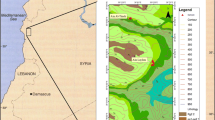Abstract
Phosphogypsum (PG), the major waste material in phosphate fertilizer processing, has been known to contain enhanced levels of naturally-occurring radionuclides especially 226Ra.The lack of radioactivity data regarding Philippine phosphogypsum and its environmental behavior in the Philippine setting has brought concern on possible contamination of groundwater beneath the phosphogypsum ponds in Isabel, Leyte, Philippines. The radioactivity of Philippine phosphogypsum was determined and the leaching of 226Ra from phosphogypsum and through local soil was quantified. Level of 226Ra in groundwater samples in Isabel, Leyte, Philippines was also quantified to address the primary concern. It was found that the 226Ra activity in Philippine phosphogypsum is distributed in a wide range from 91.5 to 935 Bq/kg. As much as 5% of 226Ra can be leached from Philippine PG with deionized water. In vitro soil leach experiments suggest that the soil in the phosphate fertilizer plant area would be able to deter the intrusion of 226Ra into the water table. Compared to reported values of natural groundwater levels of 226Ra, the concentration of this radionuclide in Isabel, Leyte groundwater suggest that there is no 226Ra intrusion brought about by the presence of phosphogypsum ponds in the area.
Similar content being viewed by others
References
Ahmed, N. K. (2004). Natural radioactivity of ground and drinking water in some areas of upper Egypt. Turkish Journal of Engineering and Environmental Science, 28, 345–354.
Burnett, W. C., LaRock, P. A., Cowart, J. B., & Hull, C. D. (1995). Microbiology and radiochemistry of phosphogypsum. Florida Institute of Phosphate Research (FIPR) Report No. 05-035-115.
El-Mrabet, R., Abril, J.-M., Periáñez, R., Manjón, G., García-Tenorio, R., & Delgado, A., et al. (2003). Phosphogypsum amendment effect on radionuclide content in drainage water and marsh soils from southwestern Spain. Journal of Environmental Quality, 32, 1262–1268.
Hakam, O. K., Choukri, A., Moutia, Z., Chouak, A., Cherkaoui, R., & Reyss, J.-L., et al. (2001). Uranium and radium in groundwater and surface water samples in Morocco. Radiation Physics and Chemistry, 61, 653–654.
Haridasan, P. P., Maniyan, C. G., Pillai, P. M. B., & Khan, A. H. (2002). Dissolution characteristics of 226Ra from phosphogypsum. Journal of Environmental Radioactivity, 62(3), 287–294.
Jankowski, J., Chruscielewski, W., Kaminski, Z., & Zak, A. (2000). Natural radioactivity of underground water supplies in the region Lodz in Poland. IRPA 10. Scientific topic-1 Natural Radiation Exposure.
Labidi, S., Dochraoui, M., Mahjoubi, H., Lamaitre, N., Ben- Salah, R., & Mtimet, S. (2002). Natural radioactive nuclides in some Tunisian thermo-mineral springs. Journal of Environmental Radioactivity, 62, 87–96.
Loyd, D. H., & Drake II, E. N. (1989). An alternate method for Ra determination in water. Health Physics, 57, 71–77.
Nathwani, J. S., & Phillips, C. R. (1978). Rates of leaching of radium from contaminated soils: An experimental investigation of radium bearing soils from Port Hope, Ontario. Water, Air, & Soil Pollution, 9(4), 453–465.
Paul, A. C., & Pillai, K. C. (1990). Leachability of radium from fertilizer and monazite process wastes. pp 83–95 In The Environmental Behavior of Radium, vol. 2. Technical Report Series No. 310, International Atomic Energy Agency, Vienna, Austria.
Pujol, L., & Sanchez-Cabeza, J. (1997). Role of quenching on alpha/beta separation in liquid scintillation counting for several high capacity cocktails. The Analyst, 122, 383–385.
Rutherford, P. M., Dudas, M. J., & Arocena, J. M. (1995a). Radium in Phosphogypsum Leachates. Journal of Environmental Quality, 24, 982–991.
Rutherford, P. M., Dudas, M. J., & Arocena, J. M. (1995b). Radioactivity and elemental composition of phosphogypsum produced from three phosphate rock sources. Waste Management and Research, 13, 407–423.
Sanchez-Cabeza, J., & Pujol, L. (1998). Simultaneous determination of radium and unranium activities in natural water samples using liquid scintillation counting. The Analyst, 123, 399–403.
Santos, A. J., Mazzilli, B. P., Favaro, D. I., & Silva, P. S. (2006). Partitioning of radionuclides and trace elements in phosphogypsum and its source materials based on sequential extraction methods. Journal of Environmental Radioactivity, 87(1), 52–61.
Ulbak, K., & Klinder, O. (1984). Radium and radon in Danish drinking water. Radiation Protection Dosimetry, 7(1–4), 87–89.
Weihai, Z., Takao, I., & Xiaotang, Y. (2001). Occurrence of Rn-222, Ra-226, Ra-228 and U in groundwater in Fujian Province, China. Journal of Environmental Radioactivity, 53, 111–120.
USEPA (1992). Potential uses of phosphogypsum and associated risks: Background information document. EPA 402-R92-002. Washington DC: USEPA.
Author information
Authors and Affiliations
Corresponding author
Rights and permissions
About this article
Cite this article
Cañete, S.J.P., Palad, L.J.H., Enriquez, E.B. et al. Leachable 226Ra in Philippine phosphogypsum and its implication in groundwater contamination in Isabel, Leyte, Philippines. Environ Monit Assess 142, 337–344 (2008). https://doi.org/10.1007/s10661-007-9933-6
Received:
Accepted:
Published:
Issue Date:
DOI: https://doi.org/10.1007/s10661-007-9933-6




